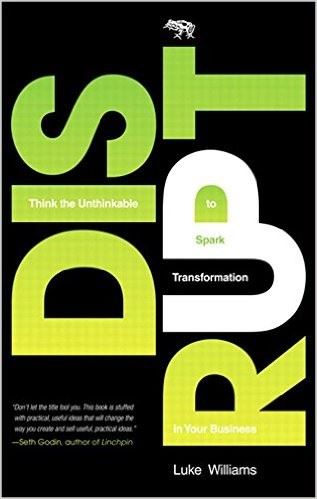Article by Patrick Sullivan
 During the ASCE National Convention in October 2015, Keynote Speaker Luke Williams, international best-selling author of the book “Disrupt: Think the Unthinkable to Spark Transformation in Your Business,” spent 90 minutes discussing innovative leadership, entrepreneurship, and cultural change. Below are some of the highlights of Mr. Williams’ oratory and slide presentation.
During the ASCE National Convention in October 2015, Keynote Speaker Luke Williams, international best-selling author of the book “Disrupt: Think the Unthinkable to Spark Transformation in Your Business,” spent 90 minutes discussing innovative leadership, entrepreneurship, and cultural change. Below are some of the highlights of Mr. Williams’ oratory and slide presentation.
Self-Similarity Principle
At conferences or social gatherings, individuals tend to migrate to or surround themselves with other professionals with education similar or identical to their own. An experiment was conducted that brought hundreds of people from a wide variety of professions to a gathering. During the course of the event, individuals with similar educations found each other, and conversations associated with their profession ensued.
Ideas Needed
To have growth in professional development, financial performance and technical advancement, you need innovators. The tasks that we work on every day are not the same as “ideas.” Ideas are recipes that we use to reconfigure items to make them more valuable so that they provide increasing returns. We then share these ideas with our profession in the form of presentations. It is important to have your ideas mix with other ideas; that is why we present and meet with others who have their own ideas. A good idea can become a better idea through the sharing/blending of two ideas.
Skip the Umbrella
Business is like the weather—we can’t accurately predict what will happen days, weeks or months from now.
The Speed of Change
There is a disease in today’s world called “no-phone-bia.” We are constantly searching our body to make sure our phone is somewhere on our person. Phones are the newest connection to information. What did we have only 15 years ago? It was simply a mobile phone – that’s all. Back in 2000, who could have predicted that smart phones would be owned by everyone? The speed of change is unbelievable. Williams refers to it as the “Pace of Disruptive Change.” In the phone industry, what happened to Nokia and Motorola? What happened to the Blackberry, now known as the “Antique Canadian Communication Device?” (He saw a Blackberry in a pawn shop on sale for $20 with a tag indicating that title.) Different professions do not look at the pace of change with respect to other professions; engineers do not see the same pace of change that the financial market sees. Change that occurs when one is forced to change is called complacent or incremental change. A company that did not change is Blockbuster Video, once a leader in its market.
Disruptive Change
Don’t spot and react. We focus on short-term patterns of activity and thinking. Williams challenges us to “be or lead the Disruptive Change” (though we likely will not be comfortable doing so). One of the elements of Disruptive Change is the “Turning Point.”
- Spark their curiosity
- Innovator has discovered a Turning Point
- Take data from the past and use it in the future
- Arrange data to make it more valuable
 Disruptive Thinking
Disruptive Thinking
Pay attention to things that are ignored. Surface the clichés. In Engineering, you have “Best Practices.” These are nothing more than accepting the standards. This is not Disruptive Thinking. Instead, take standards of practice of other professions and apply them to your profession/practice. Try not to make decisions based on historical continuity. The unbroken aspects of what we do are what we should focus on—not the problems.
Disruptive Thinking involves a five-step approach:
1. Craft a descriptive hypothesis
2. Define a descriptive opportunity in the market
3. Generate descriptive ideas
4. Shape a descriptive solution
5. Make a descriptive pitch, but sell the benefits and not the novelty
Disruptive Thinking starts with a disruptive hypothesis. If a hypothesis is a reasonable prediction, then a disruptive hypothesis is an unreasonable provocation.
Three questions you should ask in generating a disruptive hypothesis:
1. What can you invert? Example: Coke or Pepsi versus Red Bull. Coke and Pepsi have traditional advertising, they taste good, and they are reasonably priced.
2. What can you deny? Example: Rental cars versus Zipcar. For rental cars, you reserve, travel to their facility, pick up the car, give them your license and credit card, and return the car upon completion, typically at same location and at least one day later. Zipcar uses an app and “zipcard” held over a UPC code on a car window. Pick-up and drop-off occur at many designated locations, and use is typically only an hour or two.
3. What can you scale? Example: Expensive versus free or heavily discounted. The company LittleMissMatched Socks sells three socks in a package, all of which are of a different color and style. Young girls in the 8 to 12 year-old range apparently love to mismatch socks.
After disruptive hypothesis, follow with the remaining four steps.
Per Williams’ remarks, we need to have an instinct for change. Remake your landscape and use the turning points that are all around us.
